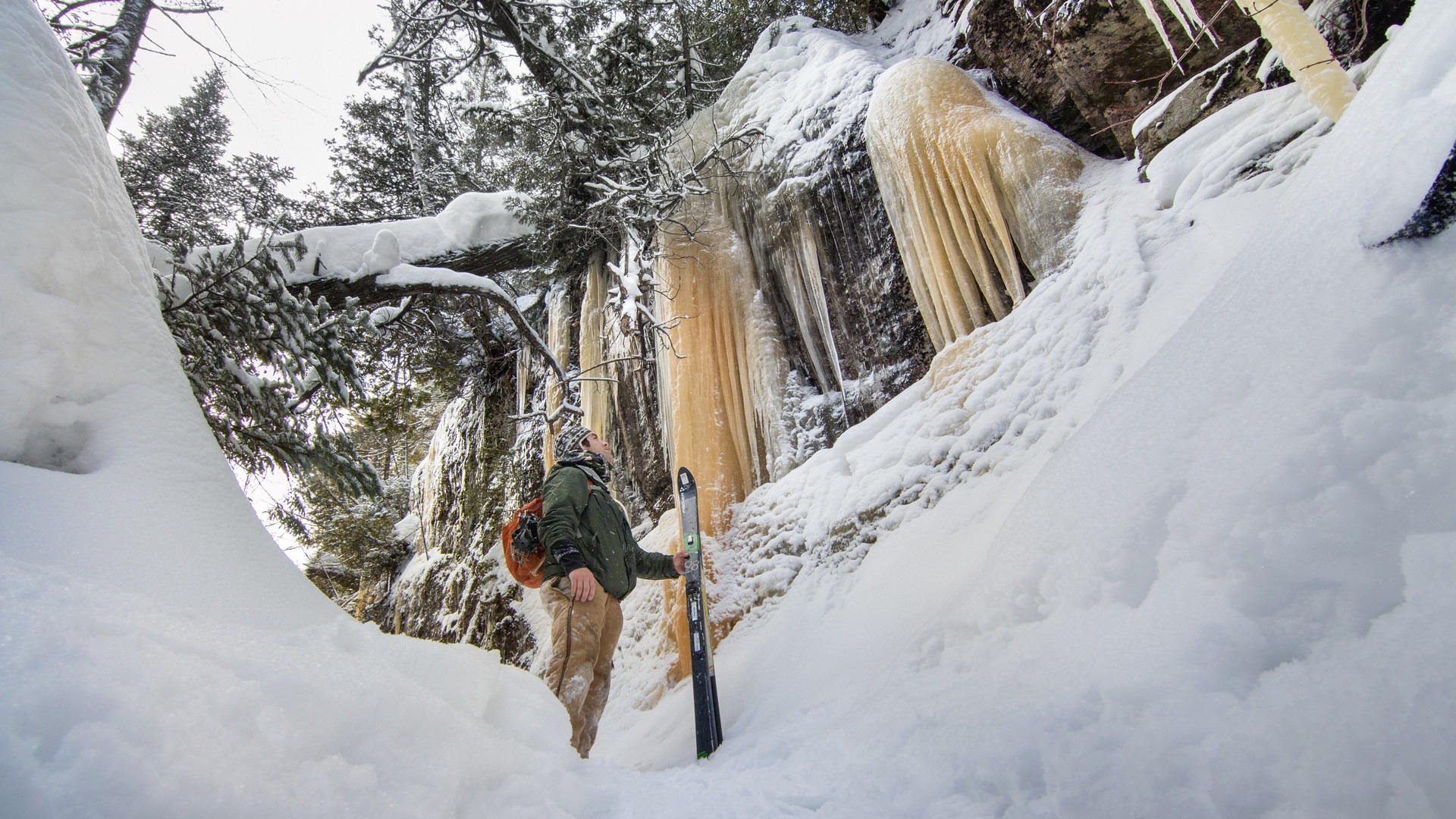You are here
The High Peaks Wilderness Area of the Adirondacks encompasses many of the highest mountains in New York state, along with sweeping valleys and shimmering waterbodies that offer stunning views and abundant adventure opportunities. Avalanche Lake is an incredible destination for many outdoor enthusiasts throughout the year, with an exceptional cross-country skiing path for the winter months. From South Meadows, this approximately 13-mile round-trip journey will take you through the heart of the High Peaks to the former site of Marcy Dam, past many trailheads for High Peaks, along Marcy Brook, near several lean-tos, and up through Avalanche Pass to this frozen wonder. This route is an extension of the cross-country trail from South Meadows to Marcy Dam.
Snowshoers looking to reach Avalanche Lake should begin at the High Peaks Information Center near the Adirondack Loj, where there is a 2.3-mile path from Heart Lake to Marcy Dam. Skiers should start at the South Meadows parking area on Adirondack Loj Road. The first mile of the trek is on a seasonal road that is relatively wide and flat. It is lined with evergreens and passes several camping areas as well as the trailhead to Mount Van Hoevenberg. There will be a divide in the road and signage; take the path to the right through a gate.
The trail will emerge at a registration box near an open marsh area. From here, the route weaves up and down over and around hills with small dips and rises. The path passes a woodsy trail back to the Adirondack Loj and continues for about 3 miles in a southerly direction. There are also a few bridges, which cross Pelkey and Phelps brooks. This former maintenance road ends on the eastern side of Marcy Dam. Here, there is a wonderful open view that stretches upstream to the prominent flat rock faces of Algonquin and Wright Peaks. Metal railings are constructed around the top of the dam for safe viewing, and the area behind is washed out with years of erosion. Beyond the water, Avalanche Mountain rises in the distance.
From the dam, follow the path to the left where there is another registration box. Look for more signs, which indicate trails to Mount Phelps, Mount Marcy, and Avalanche Lake. Follow the yellow blazes en route to Lake Colden and the Avalanche Camps. At this point, attach skins to your skis to help with the elevation gain. The path becomes narrow, and it courses through a winter wonderland along Marcy Brook. Short and steep ups and downs make the traverse more challenging. Within another mile, pass by the Avalanche Camps with several lean-tos that are likely to have accumulated several feet of snow on their roofs from the continuous snowfall.
There is one final junction with signage for Avalanche Lake. Instead of following these yellow blazes, take the trail on the left toward Lake Arnold. Notice a sign high up on a tree that marks a route specifically for skiing. Within a short distance along this path, take a right on the Avalanche Pass ski trail. Do not go to Lake Arnold. The trail zigzags back and forth across the main trail to the lake as it climbs about 500 feet in elevation. While the trail can be difficult and an intense workout, this deviation is a pleasant alternative away from the popular snowshoe path. Eventually the trail reconverges with the snowshoe trail at the beginning of Avalanche Pass. A red and white warning sign on a tree designates the area.
The lake is about a half-mile away through the pass. This well-traveled route is typically packed with snow and easy to follow. The high cliffs of Mount Colden rise to the left with massive icicles stretching down its barren rock face. Above the trees to the right, evergreens cap the summit of Avalanche Mountain. The pass itself may be populated with more icicles, tinted to a brown earthy color, that extend beyond reach. This beauty is a wonderful sight to see after such a steep climb. The path descends and suddenly emerges at Avalanche Lake. Sometimes the water is frozen and capped with snow thick enough to walk on. Check with the info center prior to leaving to see if it is safe to walk on. With Colden to your left and Avalanche to your right, these massive mountains dip into the horizon of this mile-long lake with Calamity Mountain far off in the distance. During the mid-afternoon, the sun shines directly down the pass and bathes the surroundings with a wonderful golden glow. From here, continue onto Lake Colden or return to the trailhead.
The High Peaks Wilderness Area is the largest wilderness area in the Adirondacks, covering over 300 square miles. It stretches from North Elba, Keene, North Hudson, and Newcomb in Essex County to Harrietstown in Franklin County and Long Lake in Hamilton County. Bear canisters are required when camping and fires are not allowed. Please practice Leave No Trace principles and carry out what you carry in.
Logistics + Planning
Current Weather: Powered by Dark Sky






























Comments
Sign In and share them.